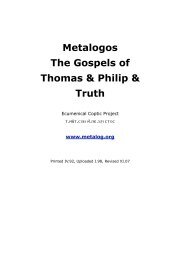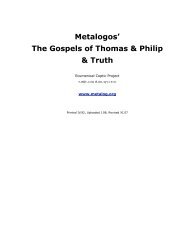Andrew Louth - Syriac Christian Church
Andrew Louth - Syriac Christian Church
Andrew Louth - Syriac Christian Church
Create successful ePaper yourself
Turn your PDF publications into a flip-book with our unique Google optimized e-Paper software.
10 INTRODUCTION<br />
no division, no separation’. Instead of being taken as safeguarding the<br />
integrity of the two natures of Christ, the phrase ‘in two natures’ was<br />
taken by many as affirming a dangerous duality in Christ, and, in<br />
particular, as betraying the doctrine of Cyril, one of those whom the<br />
council claimed to be following.<br />
From the first there were many in the East who refused to accept<br />
the Council of Chalcedon. 13 Juvenal, who had supported Dioscorus to<br />
begin with but had eventually accepted the Council of Chalcedon,<br />
returned to face riots in Jerusalem. In Alexandria, Proterius, who had<br />
been appointed to replace the deposed Dioscorus, was eventually<br />
murdered by a rioting mob. The first attempts to achieve religious<br />
unity in the Empire attempted to lay aside, or at least ignore, the<br />
Council of Chalcedon. In 482, for instance, the Emperor Zeno issued<br />
the Henotikon 14 which sought to return to the authority of the first<br />
three Ecumenical Councils, and anathematized any who think<br />
otherwise ‘either in Chalcedon or any synod whatever’; the statement<br />
of Christological doctrine in the Henotikon echoes the language of the<br />
Formula of Reunion, makes explicit that the Incarnate person is ‘one<br />
of the Trinity’, but avoids any use of the terminology of ‘nature’,<br />
whether one or two. The Henotikon found considerable acceptance in<br />
the East, though it failed to satisfy those who wanted Chalcedon<br />
unambiguously condemned: as the Henotikon received the support of<br />
all the Eastern patriarchs, this group, led by the priest Severus (later<br />
Patriarch of Antioch: 512–18), was called the Acephaloi, the<br />
‘headless’. But it did not find acceptance from Rome, that demanded<br />
nothing less than endorsement of Chalcedon and the Tome of Leo.<br />
Thus arose the Acacian Schism (so-called after the Patriarch of<br />
Constantinople, Acacius, who was largely responsible for the document<br />
and its acceptance throughout the East), which lasted until 518. This<br />
schism came to an end with the accession of the Emperor Justin I,<br />
who put the weight of imperial authority behind Chalcedon. But that<br />
was by no means the end of attempts to secure agreement between<br />
those who accepted Chalcedon and those who felt that it had betrayed<br />
Cyril.<br />
Despite the failure of the Henotikon, such attempts in the sixth<br />
century built on that document’s estabishment of the unity of Christ<br />
on the basis that the person of the union was the second person of the<br />
Trinity. This was to make explicit what had been left implicit at<br />
Chalcedon, but affirmed what had been absolutely central to Cyril’s<br />
understanding of the unity of Christ. Around the time of Justin’s<br />
accession, a group of Scythian monks in Rome suggested a formula<br />
that might bridge the gap between Chalcedon and those who, in the<br />
name of Cyril, rejected it: this was the affirmation that ‘one of the<br />
Trinity suffered in the flesh’. 15 The Pope of the time (Hormisdas: 514–




